The Killing Fields – Cambodia’s Bloody Legacy
We are travelling into Cambodia from Ho Chi Minh City by road, a five hour drive, so we can stop in Phnom Penh and visit The Killing Fields. Our “luxury” van Is filled with an interesting group.
Murray is a travelling Brit. Yo and his son are currently exiled from China, their flights home canceled because of coronavirus. Unlike Vietnam, Cambodia is still allowing flights to China. He lives in Shanghai but carries a Canadian passport because he grew up in, of all places, Winnipeg, Manitoba. He was a boat person from Vietnam as a child. Besides being interesting, his fluent Vietnamese was most helpful, as our driver kept disappearing with our passports and leaving us in various checkpoints at the border.
There is no transition between thriving Vietnam and Cambodia. Just metres past the border, the skinniest cow I’ve ever seen sauntered out in front of the van. We swerved around it on the suddenly pot-holed highway. The poverty is obvious, mean homes surrounded by trash. The countryside itself is stark but beautiful, the houses built on stilts.
Phnom Penh
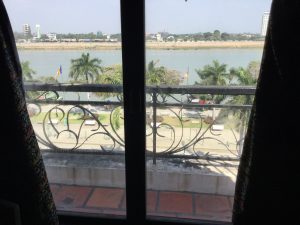 Cambodia is hot! 37 degrees when we arrived at the Phnom Penh bus station in mid-afternoon. We are soaked with sweat by the time our tuk-tuk finally arrives at our hotel. Our room is on the fifth floor, 88 long steps up into the attic of the building. When the power is on, which is most of the time we have AC, a fridge and a bit of WiFi. We also have a magnificent view of both the Mekong and the Tonle Sap rivers. In the morning and evening we climbed out of our window and sat on the balcony to watch the colourful world go by.
Cambodia is hot! 37 degrees when we arrived at the Phnom Penh bus station in mid-afternoon. We are soaked with sweat by the time our tuk-tuk finally arrives at our hotel. Our room is on the fifth floor, 88 long steps up into the attic of the building. When the power is on, which is most of the time we have AC, a fridge and a bit of WiFi. We also have a magnificent view of both the Mekong and the Tonle Sap rivers. In the morning and evening we climbed out of our window and sat on the balcony to watch the colourful world go by.
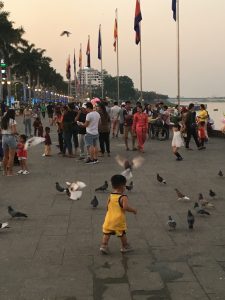 Phnom Penh was a complete surprise. It’s a modern city, fairly clean were it not for a sewage into the river issue. A thriving tourist area stretches along the river. The banks of the river come alive at night when the heat abates. Locals gather to cook and sell food and play cards. The children are playing and feeding the thousands of pigeons that clearly enjoy the nightly ritual. The water is full of funky boats, most of them somewhat functional. There are ferries, dredgers, fishermen, boat people and tourist cruises. We took a sunset cruise for $5 that included the beer.
Phnom Penh was a complete surprise. It’s a modern city, fairly clean were it not for a sewage into the river issue. A thriving tourist area stretches along the river. The banks of the river come alive at night when the heat abates. Locals gather to cook and sell food and play cards. The children are playing and feeding the thousands of pigeons that clearly enjoy the nightly ritual. The water is full of funky boats, most of them somewhat functional. There are ferries, dredgers, fishermen, boat people and tourist cruises. We took a sunset cruise for $5 that included the beer.
The Killing Fields
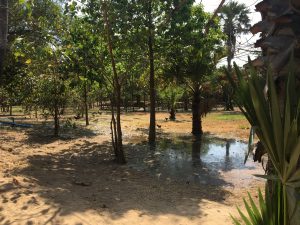 Between 1975 and 1979 the Communist Party of Kampuchea, otherwise known as the Khmer Rouge massacred anywhere from 1.5 to 3 million people. 25% of the population of Cambodia was murdered. There are mass grave sites throughout the country, but Chueng Ek, just 15 kilometres outside of Phnom Penh stands as a shrine for one of the worlds worst genocides.
Between 1975 and 1979 the Communist Party of Kampuchea, otherwise known as the Khmer Rouge massacred anywhere from 1.5 to 3 million people. 25% of the population of Cambodia was murdered. There are mass grave sites throughout the country, but Chueng Ek, just 15 kilometres outside of Phnom Penh stands as a shrine for one of the worlds worst genocides.
An audio guide leads visitors through the Killing Fields. Narrated by a survivor, and filled with first hand accounts by other survivors and people who have excavated this mass grave site, its a personal and powerful experience.
We noticed group tours had guides instead of the audio tour. That would be unfortunate. Even being near the group tours was disruptive to the experience.
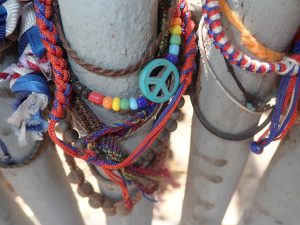 It’s a lovely place. A small lake is surrounded by a walking path. Just outside the barbed fence farmers are tending to their crops. A tall Stupa is the only significant structure.
It’s a lovely place. A small lake is surrounded by a walking path. Just outside the barbed fence farmers are tending to their crops. A tall Stupa is the only significant structure.
When the Khmer Rouge gained power in 1975, ruled by Pol Pot the country already laid in ruins. The Americans had been dropping bombs relentlessly since 1969. There are still an estimated 3 million land mines buried in the country. Pol Pot’s plan for economic development was simple – grow rice. Anyone who could not work the fields had no use. They began to round up the intellectuals, anyone with soft hands, education, even wearing glasses was a risk. They were arrested, held at S-21 prison in Phnom Penh and eventually brought to Chueng Ek to be murdered.
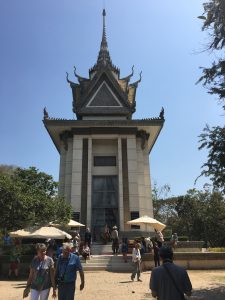 At first trucks would arrive a couple of times a month, carrying about 30 people each. By 1979 multiple trucks were arriving, carrying 300 people daily. This one mass grave site has an estimated 17,000 bodies buried.
At first trucks would arrive a couple of times a month, carrying about 30 people each. By 1979 multiple trucks were arriving, carrying 300 people daily. This one mass grave site has an estimated 17,000 bodies buried.
As you walk through the pastoral site, look down. It’s not unusual to find bones or scraps of clothing. Excavators continue to claim remnants and organize them.
The audio guide paints a vivid picture of the scenes during the massacre. People would arrive from S-21 prison tied and blind folded in the back of a truck. The panic must have been incredible, but it’s thought many would have been hoping for death by this time. The murders were conducted brutally, no bullets were wasted. Because not everyone thrown into the mass graves were completely dead, chemicals like DDT was scattered over the bodies to finish the job.
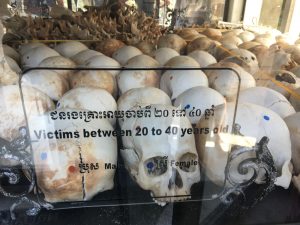 There is a music tree in the centre of the yard. Communist music would blast loudly from the time the first truck arrived until morning to cover the sounds of the killing.
There is a music tree in the centre of the yard. Communist music would blast loudly from the time the first truck arrived until morning to cover the sounds of the killing.
There is the killing tree, still stained red with blood. Babies and small women would be swung at the tree. It’s a vivid picture.
One is guided by the audio not to enter the Stupa until you are ready, and not at all if you wish. The Stupa is filled five stories high with the skulls that have been excavated. They are categorized by the age of the person and the way they were murdered. It’s impossible to capture in a photo. It’s impossible to describe with words.
Cambodia Today
The massacre finally ended when the Vietnamese Army invaded in 1979 and removed Pol Pot from power. Unfortunately he died before he could be held responsible.
Cambodia is a country in recovery, but there is a lasting effect of wiping out the intellectuals. The government is still corrupt, with some of the Khmer Rouge leaders still sitting in the senate, reportedly opining occasionally about “the good old days.” Everyone I spoke to had a personal story to tell. Most asked me not to write about it. They are still afraid.
A visit to the Killing Fields is hardly holiday fare. Travel is about gaining an understanding of the world we live in. It is important to bear witness to the brutality of humankind, to know it exists then and still. Otherwise there is no hope.


I dont think I could bear to go there. It makes me weep just to read your account
I think the point is to weep. May it never happen again, but we know it will.